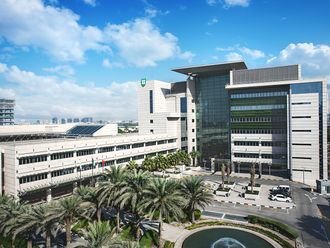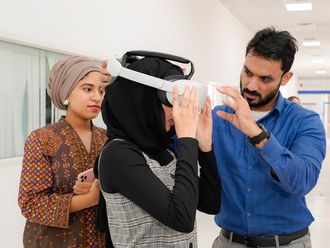Abu Dhabi: A baby boy who was born with his liver and small intestine outside his abdomen is now doing well after undergoing reconstructive surgery.
Baby Zaid, born to Palestinian parents on February 14, is home with his family, and his father, 44-year-old engineer Ashraf Abu Nar, told Gulf News it is impossible to tell that his son was born with a rare congenital deformity.
“Although it was a smooth pregnancy, we knew that Zaid had a rare congenital condition. We had never heard of such cases before. We placed our faith in God and his doctors,” he said.
At two weeks of age, Baby Zaid underwent a five-hour reconstructive surgery.Courtesy: Family
According to Dr Raja Cingapagu, paediatric surgeon at Danat Al Emarat Hospital for Women and Children, one of the doctors who treated Zaid, such cases of congenital hernias (a condition in which an organ or part of it is displaced at birth and protrudes outside its cavity) are very rare, and occur only once in around 20,000 births.
“[Baby Zaid] was diagnosed with the deformity at 12 weeks of pregnancy, and his mother was kept under observation until the delivery, which was scheduled at 37 weeks,” Dr Cingapagu said.
Tests performed on Zaid during the pregnancy had shown the absence of some muscles in the central abdomen around the navel, which led to parts of his stomach, small intestine and liver protruding from the abdominal cavity. The baby was born with the organs held in a spherical sac, and the sac itself was sealed with the lining of the umbilical cord, which allowed the organs to remain well preserved outside the body.
To prepare Baby Zaid for the reconstructive surgery, doctors used a pressure belt around the organ sac to reduce its size and increase the capacity of the abdominal cavity to accommodate the protruding organs. Dr Cingapagu said the process took two weeks, and Baby Zaid was kept in the Neonatal Intensive Care Unit during this time.
At two weeks of age, the baby then underwent a five-hour surgery.
“The umbilical lining was removed, abdominal muscles were restructured and the various organs were returned to the abdominal cavity. The opening in the abdominal wall muscles was then closed. Throughout the procedure, an advanced device was used to ensure that the child maintained regular arterial pressure in the abdominal compartment so that the organs would be safe once they were inserted,” Dr Cingapagu said.
Baby Zaid, who was born weighing 2.7 kilograms, recovered normally, and was discharged a week later.
“He is now home with my six other children, and is the darling of everyone’s eyes. My three eldest daughters are so fond of him that I always say that Zaid has four mothers,” Abu Nar said thanking the medical team for the care his wife and son received.












